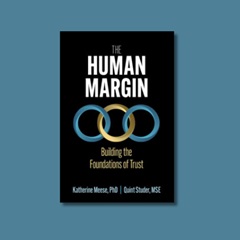
We Love ACHE’s Chapter Leaders!
Every April, we celebrate National Volunteer Week and recognize the leaders of ACHE’s 76 chapters for the work they do to provide value to ACHE membership.
Read MoreSharing relevant and meaningful insights from healthcare leaders.

Every April, we celebrate National Volunteer Week and recognize the leaders of ACHE’s 76 chapters for the work they do to provide value to ACHE membership.
Read More
We have titles for healthcare professionals at every stage of their career and are excited to share our three newest releases.
Read More
There are numerous opportunities for a pediatrician-in-chief at children’s hospitals.
Read More
A strong safety system should allow us to take risks and distinguish what was inevitable from what was avoidable.
Read More
Great leadership takes investment, and plenty of it.
Read More
Data is key to improving workforce inclusion for people with disabilities.
Read More
We have titles for healthcare professionals at every stage of their career and are excited to share our three newest releases.
Read More
Through their strategic agendas, healthcare leaders drive meaningful change in patient care and employee satisfaction.
Read More
Learn more about how an awareness of span of control can promote sustainable nursing practices..
Read More
Leaders are finding ways to make sustainability part of their solution to challenges they were already experiencing.
Read More
Learn more about Boston Medical Center’s Health Equity Accelerator.
Read More
Get to know Nick Mahoney in the Q&A below.
Read More
Meet Janan Apple, one of ACHE’s 2023–2024 Stuart A. Westbury Jr. Postgraduate Fellows.
Read More
Two heads are usually better than one, especially when the two have complementary competencies and areas of expertise.
Read More
What are the clues that something is amiss in an organization?
Read More
How to introduce more sponsoring into mentoring relationships.
Read More
We have titles for healthcare professionals at every stage of their career.
Read More
What are the clues that something is amiss in an organization?
Read More
The healthcare industry needs a revenue cycle reinvention.
Read More
Every community has its patchwork of healthcare providers who play an effective role in advancing the health.
Read More
Generous donations to ACHE’s Fund for Healthcare Leadership help support scholarship opportunities for future healthcare leaders.
Read More
Real talk about diversity, equity, inclusion and belonging
Read More
Waves have a new meaning for us as we work with leaders in healthcare organizations: waves of languishing and burnout.
Read More
Using AI, we can leverage decades of data from minimally invasive procedures and change the future of healthcare.
Read More
How to prioritize a people-centric mindset for digital transformation in healthcare.
Read More
Professional conflict resolution services play a vital role in enhancing hospital employee retention.
Read More
I am excited about the potential delivery and provider/caregiver opportunities that lie in front of us, but it will require us all to rethink care.
Read More

We have titles for healthcare professionals at every stage of their career.
Read More
Our ultimate goal is to achieve true personalized medicine, where our treatment is tailored specifically for each patient.
Read More
As you celebrate National Hispanic Heritage Month, please spend time with your loved ones and lean into the challenges that require extra hustle and grit.
Read More
More than a year after the decision in Dobbs vs. Jackson Women’s Health Organization, healthcare leaders are dealing with a wide range of effects.
Read More
There is a clear opportunity for healthcare to embrace and lead this generative AI transformation.
Read More
We have titles for healthcare professionals at every stage of their career.
Read More
Advancements in precision oncology may help clinicians make decisions about how to best manage their patients’ care.
Read More
Meet Parker D. Harris, chair of ACHE’s Early Careerist Committee.
Read More
In order to lead others well, we must first lead ourselves well.
Read More
Healthcare CEOs who responded to ACHE’s 2022 Top Issues survey ranked behavioral health and addiction third on a list of 11 concerns.
Read More
We have titles for healthcare professionals at every stage of their career.
Read More
A retired CEO discusses his eight values for successful healthcare servant leaders.
Read More
Generative AI is a dynamic and learning technology that can produce varied types of content.
Read More
We have titles for healthcare professionals at every stage of their career.
Read More
Let’s explore why price transparency efforts could be a game changer for some enterprising providers.
Read More
To be seen as a leader in life and work, we first need to see it for ourselves.
Read More

Healthcare should be about inclusion and respect and providing the best care and services possible.
Read More
For nearly two decades, healthcare organizations have been in pursuit of the elusive status of being a “high reliability organization.”
Read More
We have titles for healthcare professionals at every stage of their career.
Read More
Leadership behavior is the major factor in the formation of high-performing teams.
Read More
Something had to be done to address employee shortages and alleviate the burden it was causing on existing colleagues.
Read More
Leadership diversity in healthcare is important for creating an inclusive workplace and essential for providing better care to patients and communities.
Read More
We have titles for healthcare professionals at every stage of their career.
Read More
We all have roles to play in creating a more humane system of healthcare.
Read More
Meet Alexandra Simonton, a member of ACHE’s Early Careerist Committee and a 2022 Thomas C. Dolan Career Accelerator Program scholar.
Read More
Value-based care not only advances quality and equity in healthcare, it accelerates innovation in care delivery.
Read More
We have titles for healthcare professionals at every stage of their career.
Read More
Our current Black maternal mortality statistics are staggering in a country of wealth.
Read More
The best way to unlock the flexibility of service line master plans is to pair data analysis with traditional medical planning.
Read More
Evolving faster than ever is the blended approach of ethics and artificial intelligence.
Read More
We have titles for healthcare professionals at every stage of their career and are excited to share our three newest releases.
Read More
My recent experiences have reenergized my commitment to continue to make the U.S. healthcare space more conducive to mothers.
Read More
Digital health tools provide opportunities to transform gender inequities in the healthcare system.
Read More
Drawing from my experience as a consultant and educator, I believe transformational change requires three commitments.
Read More
Check out this month’s selections for our “What’s On Your Bookshelf?” series from Health Administration Press, the publishing division of the Foundation of the American College of Healthcare Executives.
Read More
Communication management is critical to achieving positive results.
Read More
Telemedicine has proven to be a key revenue driver and delivery platform that gave providers reach and connection with their patients when in-person care was not possible. But is this sustainable moving forward? Will we return to traditional brick-and-mor...
Read More
Check out ACHE Blog’s new series featuring ACHE’s early careerist healthcare leaders. First up is Frantz Berthaud, the chair of ACHE’s Early Careerist Committee. Learn more about Berthaud’s role and commitment to professional development in the Q&A below.
Read More
Check out this month’s selections for our “What’s On Your Bookshelf?” series from Health Administration Press, the publishing division of the Foundation of the American College of Healthcare Executives. As one of the largest publishers in the field of hea...
Read More
A decade ago, many questioned the efficacy and value of robot-assisted surgery programs in advancing care. Today, more than 30,000 peer-reviewed publications have assessed these programs, and hundreds of real-world evidence analyses have substantiated the...
Read More
Is "quiet quitting" the response of a tuned-out healthcare workforce or a sign that the work is no longer aligned with our mission? Read Jessica Melton's thoughtful perspective.
Read More
As a global company, Cardinal Health understands the long-term health of our employees, customers, partners and communities depends on a healthier, more sustainable and equitable world. As healthcare institutions and companies, it’s essential we work toge...
Read More
Asian healthcare leaders are a minority in healthcare management. A stereotype about Indians is that they are either doctors or computer professionals, so creating a space for myself in healthcare management has been a unique challenge. This is slowly cha...
Read More
Check out this month’s selections for our “What’s On Your Bookshelf?” series from Health Administration Press, the publishing division of the Foundation of the American College of Healthcare Executives. As one of the largest publishers in the field of hea...
Read More
When my friend and former colleague Beck Bailey was in a skiing accident, he faced a situation that many transgender people dread—he needed emergency medical care and likely hospitalization. He worried about whether he would be treated with respect and di...
Read More
Every year on Nov. 11, the United States pauses to collectively honor those who enlisted or commissioned to serve the nation. Some veterans serve for one tour, while others spend decades in uniform. We serve and return to our communities—some silently, so...
Read More
This month, we observe Veterans Day, a time to celebrate those who’ve answered the call of duty and show them our appreciation. I spent 35 years in uniform, a privilege that gave me a front-row seat to the selfless work the many millions of veterans in ...
Read More
Check out this month’s selections for our “What’s On Your Bookshelf?” series from Health Administration Press, the publishing division of the Foundation of the American College of Healthcare Executives. As one of the largest publishers in the field of hea...
Read More
Work in the clinical laboratory has been transformed in recent years through advances in digital pathology, artificial intelligence, automation and digital information flow. The profound changes brought about by these technologies are only the beginning, ...
Read More
In late 2017, NorthShore University HealthSystem developed a bold three-year vision and plan, which included converting a full-service hospital into Illinois’ first dedicated orthopaedic and spine hospital, implementing an advanced and innovative clinical...
Read More
Mike Peresie is the senior vice president/general manager of Decision Support and Revenue Cycle Management Technology at Change Healthcare. He leads the organizations that manage both the Change Healthcare RCM software portfolio (including Clearance, Assu...
Read More
Learn about one ACHE member’s family history and experience in the Alaska Native Tribal Health Consortium
Read More
Learn about designing healing environments: efficiency, access to nature, clutter, way-finding, and the healing arts
Read More
Check out this month’s selections for our “What’s On Your Bookshelf?” series from Health Administration Press
Read More
Learn about the disparities in healthcare that have persisted throughout our history
Read More
Marcos Pesquera, president-elect of National Association of Latino Healthcare Executives, reflects on his upbringing
Read More
Take a look at U.S. airline safety in the recommitment to zero patient harm
Read More
Learn how healthcare organizations are employing artificial intelligence to gain clinical and operational efficiencies
Read More
Check out this month’s selections for our “What’s On Your Bookshelf?” series from Health Administration Press
Read More
Recognizing the rising colorectal cancer incidence in younger patients, many organizations have updated their screening guidelines
Read More
Learn from a Q&A with ACHE’s most recent summer intern Morgan E. Krizan
Read More
Learn from Jeff Prater, of Carson Valley Medical Center, where he has led the hospital through multiple wildfire threats to the area
Read More
Check out this month’s selections for our “What’s On Your Bookshelf?” series from Health Administration Press
Read More
Dwayne Keeling is a passionate advocate for mentoring, and he shares his insights about the importance of a mentoring relationship and how to make the most of it
Read More
Learn about the experience of transitioning from the U.S. Air Force to a civilian healthcare executive role
Read More
Learn about the metrics that matter and help managers factor them into operational strategies
Read More
Learn about the benefits of the Leader-to-Leader Rewards Program
Read More
Check out this month’s selections for our “What’s On Your Bookshelf?” series from Health Administration Press
Read More
Learn about healthcare’s workforce crisis, the human capital questions in play, and the need for reasoned responses
Read More
African Americans remain the least healthy ethnic group in the United States. Read how systemic causes of suboptimal black health require equally systemic solutions
Read More
Read about healthcare’s opportunity to deploy AI to achieve better return on investment, and what health systems are already achieving
Read More
Read about James R. Allard, chair of ACHE’s LGBTQ Healthcare Leaders Community Committee, and his thoughts on leading in challenging times
Read More
Read about ways to embed equity into safety and quality work, and how to protect and support the workforce
Read More
Check out this month’s selections for our “What’s On Your Bookshelf?” series from Health Administration Press
Read More
Learn about hospitals and health systems’ need for leaders who support cultures that focus on addressing systems issues that contribute to errors and harm
Read More
Following the pandemic, healthcare workers are tired and emotionally drained. Read for Swati Bhardwaj’s thoughts on rekindling a passion for healthcare
Read More
Read about the imperative of improving transitional care, and methods for effecting change
Read More
Read about methods of actively reimagining a healthcare workplace that actively supports women
Read More
Check out this month’s selections for our “What’s On Your Bookshelf?” series from Health Administration Press, the publishing division of the Foundation of the American College of Healthcare Executives. As one of the largest publishers in the field of hea...
Read More
Read about the three R’s that have implications for cybersecurity in Healthcare: Russia, ransomware and resiliency
Read More
Read about three health systems that are reducing negative environmental impact
Read More
A Path Forward: Addressing Clinician Burnout Through Systems-Level Change
Read More
While the COVID-19 pandemic has shone a spotlight on burnout in the healthcare community, it is a “preexisting condition.” Burnout is defined as a work-related stress reaction that leads to emotional exhaustion, depersonalization and a lack of sense of pe...
Read More
Check out this month’s selections for our “What’s On Your Bookshelf?” series from Health Administration Press, the publishing division of the Foundation of the American College of Healthcare Executives. As one of the largest publishers in the field of hea...
Read More
Read about the new public health imperative facing hospitals in the midst of the COVID-19 pandemic
Read More
Read about methods to build workforce resiliency and well-being, and why it is important to do so
Read More
Read about how one of the greatest challenges to the future of U.S. healthcare is not access to financial capital, but access to and the retention of skilled talent
Read More
Read as five women share their advice for emerging women leaders, their personal mottos, what skills have been useful in furthering their careers
Read More
Check out this month’s selections for our “What’s On Your Bookshelf?” series from Health Administration Press, the publishing division of the Foundation of the American College of Healthcare Executives. As one of the largest publishers in the field of hea...
Read More
Learn about methods of creating a new model to measure hospital performance
Read More
Enforcement of the Centers for Medicare & Medicaid Services’ COVID-19 vaccine mandate began January 27. Here's an explanation of the mandate and useful information for healthcare leaders about enforcement deadlines.
Read More
Find information about our Senior Executive and Executive Programs, ACHE's day of giving, and info on why it's important to support the next generation of healthcare leaders
Read More
Read the inspiring backgrounds of 8 black pioneers in medicine
Read More
Check out this month’s selections for our “What’s On Your Bookshelf?” series from Health Administration Press
Read More
Learn methods for prioritizing the replenishment and well-being of your workforce
Read More
Read about process and structural alignment in the supply chain, human resources and finance functions of a multifunctional health system
Read More
Read how assumptions and biases interfere with care
Read More
Read to see three successful strategies our members are using to reduce staff burnout
Read More
Embarking on a new strategic plan is an opportunity to amplify strengths and identify new opportunities. This moment is particularly important as we chart a course for our profession in a post-pandemic world. For ACHE, this means elevating what makes us u...
Read More
Check out this month’s selections for our “What’s On Your Bookshelf?” series from Health Administration Press, the publishing division of the Foundation of the American College of Healthcare Executives. As one of the largest publishers in the field of hea...
Read More
Read for five tips for engaging your team in problem-solving efforts
Read More
Read for tips on worker well-being and pandemic recovery efforts
Read More
Learn about strategies for cultivating a workplace culture of belonging through modeling kindness and curiosity
Read More
Read for ten different steps to building organizational resilience
Read More
This year, I was honored to have been chosen as a Thomas C. Dolan Executive Diversity Program Scholar. This was a hugely exciting achievement for me, as I have admired Dolan Scholars from afar since the program’s inception in 2014 and I aspired to eventu...
Read More
Check out this month’s selections for our “What’s On Your Bookshelf?” series from Health Administration Press, the publishing division of the Foundation of the American College of Healthcare Executives. As one of the largest publishers in the field of hea...
Read More
Read a robust list of top skills that hospital CEOs need to navigate the pandemic
Read More
John W. Sharpe, director of SCI&D Rehabilitation Services, describes his experience with VA and ACHE
Read More
Find tips for creating the environment and culture to address workforce challenges
Read More
Read about Nichole Wilson’s successful pivot from being a practicing physical therapist to a healthcare executive
Read More
Check out this month’s selections for our “What’s On Your Bookshelf?” series from Health Administration Press, the publishing division of the Foundation of the American College of Healthcare Executives. As one of the largest publishers in the field of hea...
Read More
Read four key elements that are essential to managing employee retention
Read More
Read for the how and why noise-managed facilities importantly improve patient care
Read More
Read about ways to adapt and help enhance the patient experience by providing the tools and information to help empower the consumer
Read More
Read about Monica C. Vargas-Mahar’s experience as a latino leader in healthcare
Read More
Read about the experience of Astrid Gonzalez Parrilla as a latino leader in healthcare
Read More
Read about the San Carlos Apache community’s experience during the COVID-19 pandemic
Read More
Explore how one can successfully transition to a new role, even during times as uncertain as the COVID-19 pandemic
Read More
Since the launch of our Healthcare Executive Podcast in early 2019, we have connected with numerous healthcare professionals, innovators and industry leaders from across the country. In each episode, these experts share their insights on topics ranging fr...
Read More
Check out September's selections for our “What’s On Your Bookshelf?” series from Health Administration Press, the publishing division of the Foundation of the American College of Healthcare Executives. As one of the largest publishers in the field of heal...
Read More
Learn how to best balance safety and empathy in patient visitation policies
Read More
Read about the meaningful and powerful benefits of ACHE’s wide-reaching professional network
Read More
Read about best ways to foster equity in patient safety for all healthcare leaders
Read More
Read guidance for how healthcare executives can advance strategies that interrupt the cycle of gun violence
Read More
Read about simulation education, and the bridge between classroom learning and real-life clinical experience
Read More
Read to understand five benefits of mentorship – for you and your mentee.
Read More
Check out August 2021's selections for our “What’s On Your Bookshelf?” series from Health Administration Press, the publishing division of the Foundation of the American College of Healthcare Executives. As one of the largest publishers in the field of he...
Read More
Read how biomarker testing provides new options for clinicians and patients
Read More
Learn more from our colleagues at the Department of Veterans Affairs about the opportunities you can have working at the VA
Read More
Read about Baldrige Hospital’s championing of agility and process improvement during the pandemic
Read More
Read here to learn about simple methods of operationalizing data
Read More
Read here to learn about methods of incorporating sustainable practices
Read More
Check out July 2021's selections for our “What’s On Your Bookshelf?” series from Health Administration Press, the publishing division of the Foundation of the American College of Healthcare Executives. As one of the largest publishers in the field of heal...
Read More
Read how healthcare leaders have an opportunity and responsibility to lead with mental health in mind
Read More
Read here for a good reminder that the duty of healthcare leadership is to plan, to safeguard and to guide
Read More
Read about risks to healthcare workers in the pandemic and the new ETS
Read More
Read here for methods of boosting workplace health and wellness
Read More
Read why managing oneself is crucial to better managing others
Read More
Read here for methods of leading and rewarding a just culture in a healthcare workplace
Read More
Read about the importance of aiming to achieve health equity, with a special consideration for the LGBTQ+ population
Read More
Read about the four Cs of building trustworthiness: competency, caring, communication, comfort
Read More
Read for several steps those of us in the field can take to improve health equity for our most vulnerable populations
Read More
Read to learn about methods of improving patient flow following the pandemic
Read More
Like many health systems, Mon Health’s employed provider network has created new challenges. Mon’s network grew substantially over the past decade through practice acquisition and incremental recruitment. However, due to the nature of the medical group’s ...
Read More
Read to learn about ways of collaborating with other healthcare leaders to strengthen inclusion efforts
Read More
Find strategies here for moving forward in the job search following a rejection letter
Read More
Read for tips on navigating and initiating new, post-pandemic normals in the workplace
Read More
Find successful strategies here to help leaders stay focused on building key workforce skills
Read More
In recognition of the American Hospital Association’s National Hospital Week, the healthcare community highlights its hospitals
Read More
Read here to find out ways in which health disparities similarly effect Asian Americans
Read More
Find tips for effective clinician collaboration here
Read More
Read here to see how we all play a part in advancing awareness, education and access to mental health resources
Read More
Hear from Stephan Davison and his perspective on national minority health month
Read More
Read Baljeet S. Sangha’s excerpt from the Spring 2021 Regent Message for the California—Northern & Central area
Read More
ACHE is proud to recognize National Volunteer Week. Read about the benefits of volunteering
Read More
Leaders interested in furthering their education and development can gain new insights by checking out the following books
Read More
Read Dr. Anthony Fauci’s key takeaways during this time of crisis
Read More
Read why one physician executive values National Doctors’ Day
Read More
Read for methods of managing healthcare worker safety aside from vaccinations
Read More
Read to learn why it is crucial to focus on quality improvement and leverage Six Sigma
Read More
Read this blog to understand key succession planning tips from the American College of Healthcare Executives
Read More
Read to see how healthcare leaders can make meaningful change in ending health inequities
Read More
Find a case study here on Chapters Health System's success in reinventing community-based healthcare
Read More
Learn methods for improving diagnostic quality -- and why it matters
Read More
Find healthcare leader's perspective on Black History Month by reading here
Read More
ACHE has been dedicated to advancing members and leadership excellence ever since being chartered on Feb. 13, 1933. To celebrate more than 85 years of supporting healthcare leaders through resources, education and networking, the association is excited to...
Read More
Read how volunteer teams can have an impact in deciphering information
Read More
Read how our collective safety efforts can have drastic impact on all communities
Read More
Martin Luther King Jr. stated in his book Strength to Love, “The ultimate measure of a man is not where he stands in moments of comfort and convenience but where he stands at times of challenge and controversy.” This specific quote has been a core princip...
Read More
A healthcare leader shares the importance of caring for your workforce well
Read More
Learn tips for gauging the state of your hospital or health system's financial health
Read More
Read how the quality, location and cost of housing can deeply impact overall health in both children and adults
Read More
Read information on 4 focus areas in advancing patient safety in your practice
Read More
CEO Deborah Bowen recognizes the incredible courage and determination our field has shown this year
Read More
Read how healthcare leaders have the opportunity to advance gender equity
Read More
Read about mission-critical work in healthcare and the impacts of COVID-19 on that work
Read More
Find ACHE's available resources to veterans here
Read More
Read how the COVID-19 pandemic has changed expectations of hospital leaders' performance
Read More
Read insightful survey results on male versus female perception of healthcare workplaces
Read More
Read for a perspective of a healthcare leader navigating the COVID-19 pandemic
Read More
Read about the negative impact AI and machine learning can have on human interaction and patient safety, including gender and racial bias
Read More
Read about the way in which indigenous communities have received COVID-19 care
Read MoreAccess popular podcast episodes for healthcare executives here
Read MoreRead here to learn about actionable ways for executives of all levels to mitigate racism in the healthcare field
Read MoreRead for tips on implementing innovations and solutions that impact the healthcare field
Read MoreFind out more about how to tackle challenges and respond to the pandemic with innovative solutions
Read MoreFind strategies that equip you and your team to be resilient in response to the COVID-19 pandemic
Read MoreFind out the benefits and the importance of sponsoring diversity in the workforce here
Read MoreFind methods of establishing organizational behavior expectations by reading here
Read MoreRead about the perspectives of a hospital actively responding to the challenges of COVID-19 here
Read MoreFind out more about ACHE's resume review services that will help give you an advantage on your application
Read MoreFind tips from ACHE for succeeding in an interview here
Read MoreFind out methods for engaging your board members successfully here
Read MoreRead about a healthcare leader's perspective on working during a pandemic
Read MoreLearn about the realities of health disparities that are exacerbated during the COVID-19 pandemic
Read MoreRead about ways to move towards a healthier, more equitable future in healthcare
Read MoreRead about how crisis management can be optimized during the COVID-19 pandemic
Read MoreRead about an executive's experience in taking action as a result of the COVID-19 pandemic
Read MoreRead about perspectives on pride month from ACHE's LGBTQ Forum Chair
Read MoreLearn about the importance of taking safety into consideration in the selection and development of leaders
Read MoreFind all you need to know about our postgraduate fellowship with insights and resources from the executives themselves
Read MoreRead perspectives on restarting elective procedures amid the pandemic
Read MoreRead about how the pandemic has spurred a dialogue between healthcare and politics
Read MoreRead here for methods of optimizing ED patient flow during the pandemic
Read MoreLearn tips for preparing for a job search during a pandemic
Read MoreLearn tips for managing your supply chain during a pandemic here
Read MoreRead a post celebrating our front-line workers during COVID-19, recognizing their contributions to the community
Read MoreRead about a healthcare leader's perspective on navigating leadership through a pandemic
Read More
Read about healthcare executives' opportunity to lead in a pandemic
Read MoreRead about PPE alternatives that might be available for deployment during the COVID-19 pandemic
Read More
Find out about the exponential growth that can occur during times of crisis
Read MoreFind out more about the impacts COVID-19 has had in rural America
Read MoreRead here to learn about how to use COVID-19 as an opportunity to build upon our own strengths and weaknesses
Read MoreRead more about what is foremost on physician leaders minds when navigating the pandemic
Read MoreRead about the COVID-19 pandemic's current effects - what we predicted, and what we missed
Read MoreAccess COVID-19 resources for healthcare professionals here
Read MoreRead about perspectives on leading through the COVID-19 pandemic from healthcare leaders themselves
Read MoreWhat does it take to truly establish a culture of safety in your hospital? According to Mark P. Jarrett, MD, senior vice president and chief quality officer at Northwell Health in New York, the secret to success is none other than leadership. And, he clai...
Read MoreFind out how to discover better methods for delivering care that is more patient and family-centered, safer and more efficient
Read MoreLearn more about how Laura S. Kaiser, FACHE, strives to never lose sight of her focus on meeting the needs of the individuals in each of her organization’s communities
Read MoreLearn from Diane L. Dixon, EdD, who conducted a study to understand how racially and ethnically diverse healthcare executives navigated the executive path to the C-suite
Read MoreSeth A. Waldman, MD, discusses the opioid prescribing processes that need to change to achieve cultural transformation in pain management.
Read MoreAccording to the results of the 2019 Kaufman Hall Healthcare Consumerism Index, healthcare providers struggle to meet and exceed consumer needs and expectations. Only eight percent of top tier healthcare organizations are focusing on a consumer-centric in...
Read MoreAlan S. Kaplan, MD, FACHE, evaluates new opportunities your organization can chase while fully and successfully executing on core strategies
Read MoreLearn about how providers need to adapt to the new environment through collaboration, innovation, technology adoption and preparation
Read MoreLearn about how Stephen Lawless, PhD, discovered measurable benefits in patient outcomes
Read MoreLearn about strategies for recruiting and retaining talent to ensure the delivery of quality healthcare in their communities
Read MoreLearn strategies to make the most of ACHE's robust career services and networking opportunities
Read MoreLearn more about how humility, compassion, and kindness can go along way in leading your organization to long-term success
Read MoreAt 4 a.m., a nurse walked into the surgical waiting area and told me my dad had died on the operating table during heart surgery. I asked her the cause of death and she replied, matter-of-factly, “Your father bled out. He just couldn’t seem to hold the su...
Read MoreLearn from Fayola Edwards-Ojeba, MD, on how to evaluate and address burnout in female physicians
Read MoreScott A. Mason, DPA, FACHE, shares his observations about consulting that may be helpful for leaders contemplating a career change
Read MoreLearn how to leverage internal culture differences to create a sustainable partnership for effective change
Read MoreLearn how to create and sustain a culture of safety through trust, respect and inclusion
Read MoreIn this six-part blog series, we will explore some of the high-level strategies and practical tactics that are critical for creating safer healthcare environments
Read MoreLearn about James E. Orlikoff's five principles for ensuring board competencies of all sizes
Read More
Learn about the importance of physician leaders receiving the necessary training needed be effective collaborators and partners
Read More
Learn about Choice tailors professional development programs, seminars and assessments to meet an organization’s learning needs or close competency gap
Read MoreLearn about the Lean effect of helping healthcare organizations and entire health systems improve patient care, reduce errors, increase patient and staff satisfaction
Read MoreLearn about our systems approach, which can make advances in quality improvements, spread best practices, and promote reduction in preventable injury
Read MoreThis podcast discusses leadership’s role in establishing a patient safety culture and provides perspectives from clinical and administrative viewpoints
Read MoreLearn about the importance and impact of leadership in patient safety here
Read MoreWhat can you, as a healthcare executive, do to aid your organization’s transformation into a high-reliability organization that delivers safer care and saves lives? Whether you’re a middle manager or a member of the C-suite, there is a role for you in bui...
Read MoreExperts in healthcare safety have given us a playbook of common sense strategies health systems can employ to begin or continue making the transition to harm-free care.
Read MoreRead perspectives on preventing readmissions at various levels of care here
Read MoreLearn more about the connection between equity and the delivery of safe and quality care
Read MoreThere is nothing more important for healthcare providers than ensuring the safety of their patients and workforce. And, ACHE is committed to catalyzing healthcare leaders around safety.
Read MoreThis article highlights different strategies that organizations can take to drive towards the ultimate goal of safety
Read MoreCEO Deborah Bowen discusses the importance of leading deliberately, effectively, and with intent
Read More